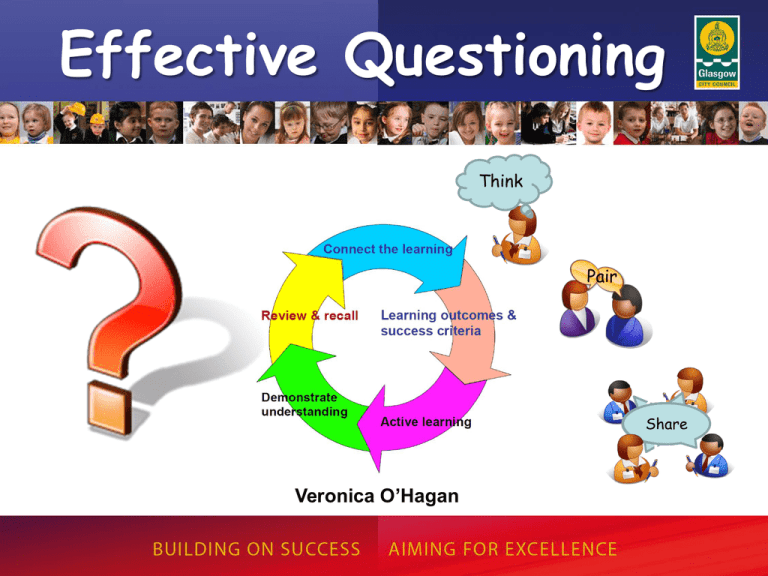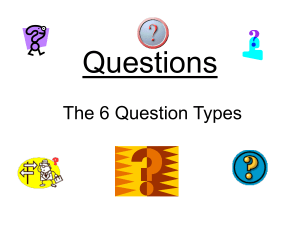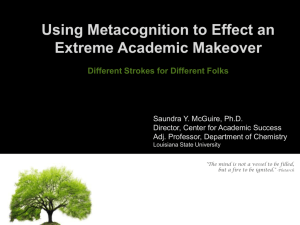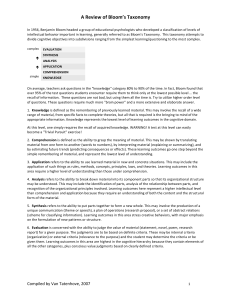Effective Questioning Workshop
advertisement

Effective Questioning Think Pair Sha Share re Veronica O’Hagan A Curriculum for Excellence It is not “What we teach” but “How we teach” and “how children learn” that will make a difference What would we like to take away from Today? What do we already know about Effective Questioning? By the end of this session we hope that you can... •Identify different types of questions •Understand what effective questioning techniques are • See how you could use them in your own teaching. Asking Questions Issues raised • Ask questions once or twice every minute • 70,000 times a year • One million questions in 15 years 57% are managerial 35% are lower order/factual recall 8% are higher order in primary school 4% are higher order in secondary school Questions from video • Do I ask varied and searching questions? • Do I give time for extended answers? • Do I give clear, effective feedback? We learn ... 80% experience personally 90% explain to others 70% discuss with others 50% see and hear 30% see 20% hear 10% read What makes a good question? Think Pair Share Thinking skills: Bloom’s Taxonomy I can use the information to build new ideas I can say what I think about the information and back up my opinion I can break down the information to understand it better I can use the information in a new way I can explain the ideas in the information I can remember facts about the information Creating How could you change the plot...? Evaluating What would you say is the importance of…? Analysing Applying Understanding Remembering What evidence can you find to…? What questions would you ask of…? How could you say that in your own words…? Where does it say…? When/why/how did…? Applying Bloom’s using the story of Goldilocks and the Three Bears Creating: Judge whether Goldilocks was good or bad. Defend your opinion Evaluating: Propose how the story would be different if it were Goldilocks and the Three Fish Analysing: Compare this story to reality. What events could not really happen. Applying: Demonstrate what Goldilocks would use if she came to your house Understand: Explain why Goldilocks liked Baby Bear’s chair the best Remember: List the items used by Goldilocks while she was in the Bears’ house Bloom’s Taxonomy: Numeracy - Bar Graphs Creating: A bar graph is a good method for representing data when….. Justify your answer. Evaluating: What information does the bar graph tell us about this situation? Analysing: Compare a bar graph to a pie chart Applying: Draw a bar graph to represent a set of data Understanding: Explain when to use a bar graph Remembering: List the main parts of a bar graph Your turn to decide … Using the story, “Little Red Riding Hood.” Which level of Bloom’s Taxonomy are these? 1. Illustrate the main idea of the story on a poster. Applying 2. Rank the characters from best to worst and explain how you ranked them Evaluating 3. Create a new story by placing Red Riding Hood in a modern city setting Creating Types of questions A • • • Closed, Lower-Order, Skinny, Cold question that requires a yes/no or a simple factual answer. They have a place in the classroom They test recall They test factual knowledge – What is the…? – Calculate… Open, Higher-Order, Fat, Hot A question that is designed to promote higher-order, independent thought. • Responses are expected to be reflective, requiring thinking time. Which would you use? Describe the differences between a 2D and a 3D shape Are these: Closed, Lower-Order, Skinny, Cold Open, Higher-Order, Fat, Hot ? If closed, can you make them open? What is 7 x 8 ? Classroom climate be yourself make statements make mistakes interrupt agree or disagree be honest ask questions no put-downs no sarcasm enjoy yourself Question stems Promote & extend children’s thinking... In your groups, think of some question stems that could be used at these places in a lesson: When children begin a piece of work While children are working If children are having difficulties At the end of a piece of work Questioning techniques B Tell Your Neighbour Idea O thoughts U N C I N G Assessment Thumbs up Body language Show me boards Smiley faces Traffic Lights Have we met our success criteria? •Identify different types of questions •Understand what effective questioning techniques are • See how you could use them in your own teaching. References/further reading References/further information • Active Learning through Formative Assessment: Shirley Clarke, Hodder Education • Asking Better Questions: Ian Smith, Learning Unlimited • Assessment & Learning Pocketbook: Ian Smith, Teachers’ Pocketbooks • Mathematics inside the black box: Jeremy Hodgen and Dylan Wiliam, GL assessment •Assessment for learning: why, what and how?: Dylan Wiliam, Institute of Education



